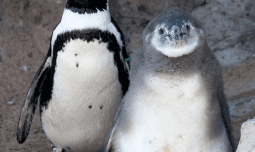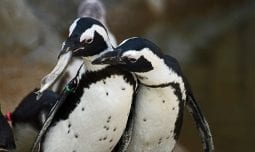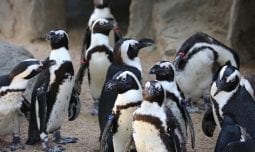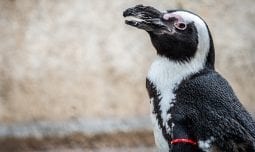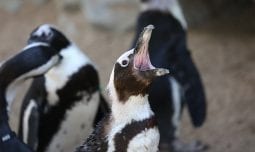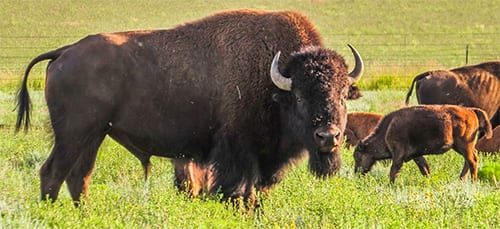Classification
Class Aves
Order Sphenisciformes
Family Spheniscidae
Genus Spheniscus
Species demersus
Habitat & Range
African penguins, also called black-footed penguins, nest on sandy or rocky islands and mainland beaches with temperate climates, and they forage for food in cold ocean currents whose temperatures range from 42 to 68 degrees Fahrenheit (5-20° C).
This species lives only on coastal islands and the mainland of southwestern Africa from Namibia to South Africa.

African (Black-Footed) Penguin
Spheniscus demersus
Penguins are flightless birds that virtually fly through the water. They have a streamlined torpedo-shaped body and wings that have been reduced to strong, stiff flippers that help rapidly propel them through the water. They have webbed feet and legs that are set back on the body. The legs and tail are used like rudders for steering. Diving down to catch fish, African penguins can stay under water for as long as five minutes and can swim at an average rate of three to six mph (5-10 kph).
Adaptations
- African penguins are excellent swimmers and divers, flying through the water rather than the air.
- Their streamlined torpedo-shaped bodies allow them to swim at three to six miles per hour (5-10 km/h) and reach speeds higher than thirteen miles per hour (20 km/h).
- Their wings are modified into stiff flippers and their legs and tail act as rudders providing agility in the water.
- They can swim more than 40 miles (65 km) in search of food.
- Unlike most birds, they have solid, heavy bones that enable diving.
- African penguins have short, dense feathers with fluffy down at their bases that overlap like shingles to repel water and provide insulation.
- Glands at the base of the penguins’ tails yield oil that waterproofs their feathers.
- A layer of fat provides additional protection against chilly ocean waters.
- To stay comfortable on land during warm weather, penguins have exposed pink skin above their eyes that allow heat to escape when blood is sent to them.
- Their black backs and white undersides, known as counter-shading, help camouflage them from predators in the water and in the air.
Physical Description
- African penguins are small penguins standing between 24 and 27 inches tall (60-70 cm) and weighing between six and nine pounds (2.7-4 kg). Males are slightly larger than females.
- Their bodies are torpedo-shaped; their backs are black and their chests and bellies are white with a black inverted U-shaped stripe.
- Small black spots on their chests are unique to each individual.
- Their large black heads have C-shaped white feathers surrounding each side of their faces and sharp pointed beaks.
- They stand upright on black webbed feet and walk awkwardly on land.
Diet
What Does It Eat?
In the wild: African penguins eat sardines, anchovies, mackerel, squid and crustaceans.
At the zoo: Their diet includes thawed herring and capelin plus a supplement that replaces nutrients lost during the freezing/thawing process.
What Eats It?
African penguins are preyed upon by seals, mongoose, leopards and sharks. Gulls and ibis prey on chicks.
Social Organization
African penguins are very social animals. They nest in colonies of 50-100 called rookeries and frequently vocalize to establish pair bonds, defend nesting sites and communicate between mates in the ocean and on land.
Life Cycle
African typically stay with a mate for an extended amount of time once a pair bond is formed Young males court females by dancing and beak slapping. The pair establishes a bond by sharing loud, harsh calls that sound like a donkey braying. They nest in shallow depressions either on open ground or under a bush or rock. Females usually lay two eggs which are incubated by both members of the pair for about 40 days. Hatchlings are covered in gray or gray-brown down and are brooded constantly for about fifteen days until they can regulate their temperatures. During the first thirty days, the parents take turns feeding the hatchling partially digested regurgitated food while the other parent forages. When the chicks are a month old, they are left in nursery groups to stay warm and shelter from predators while both parents forage but continue to be fed until they fledge at 60 to 130 days. Once they fledge, they leave the colony for one to two years sporting their new plumage of gray backs and white fronts. Most return to their birth colony prior to molting into adult plumage. Females are usually mature at three years old and males at four years. Life span in their natural environment is fifteen-twenty years. African penguin males in institutions accredited by the Association of Zoos and Aquariums have a median life expectancy of about 17 years; females about 15 years.
Collection Connection
- Denver Zoo’s African penguin flock has members ranging in age from one year to 28 years. The majority of the flock was hatched at Denver Zoo.
- To maximize successful hatching, animal care staff replace eggs in nests with dummy eggs and incubate the real eggs in an incubator, returning just-hatched chicks to their parents for rearing.
Conservation Status
IUCN Status: Endangered
Threats to African penguins include overfishing of sardines and anchovies which are staples of their diet and pollution from oil tankers sailing around the Cape of Good Hope. Oil spills in the past killed thousands of penguins. Two Denver Zoo staff members participated in rescuing and cleaning thousands of birds that were the victim of a 2000 spill. The Association of Zoos and Aquariums, of which Denver Zoo is an accredited member, is an important financial supporter of African penguin conservation projects.

Download the App!
Get the FREE Denver Zoo app today, and be a pro the next time you visit the Zoo. You’ll get access to the Zoo map, daily activities and schedules, animal facts, and more. You can even load your membership card onto the app for additional convenience. It puts everything you need for an amazing Zoo experience right into the palm of your hand!
